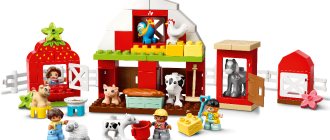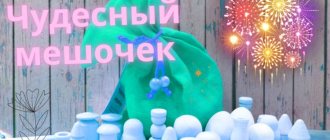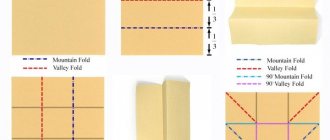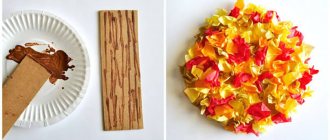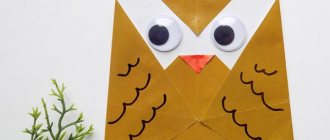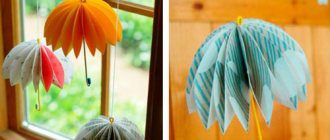MAGAZINE Preschooler.RF
Summary of a design lesson in a multi-age group “Truck”Goal: developing the ability to create an object from a TIKO constructor in accordance with the diagram.
Objectives: Educational: to develop the ability to correlate a real object with a diagram. Introduce the plan of analysis of both the subject itself and its schematic representation.
Educational: Cultivate accuracy in work, strive for results. Develop the ability to not interfere with your friend while building a car. Instill in children responsibility for their own safety; street culture.
Developmental. To develop in children the ability to read diagrams, to determine from the diagram what building parts the machine is built from. Develop skills in constructing statements and reasoning.
Methodical techniques:
- visual
- verbal
- practical
- problem-search
- encouragement
Material: handout: TIKO designer parts, diagrams.
Progress of the lesson.
1. Educator: Guys, look, we have guests today, let’s say hello to them.
Educator: who else came to visit us? slide 1
Children: Masha.
-Teacher: Guys, Grandma decided to move to a new house and asked Masha to help her, but Masha doesn’t know how to transport things and furniture.
- Shall we help Masha move her things?
-What do you guys think, what can you use to transport things and furniture?
(Truck)
- Look at the screen, which of these cars can you transport things on? slide 2
-Name the cars (car, concrete mixer, motorcycle, school bus)
- Guys, we don’t have a truck, what should we do? Children: (build).
— What can you build a truck from? (from constructor)
-Why is it called cargo? (Transports various cargoes)
Let's take a look at the truck! (children examine the structure of building parts, identify the main functional parts in it, determine their spatial position, size and shape). slide 3
— Tell me, guys, what is the name of the front part of the truck? (driver's cabin).
— Which part of the machine is the heavy load loaded into? (into the body)
-Which part of the truck was not named? (wheels)
— What kind of cargo do you think trucks can transport? (boards, logs, bricks, potatoes, etc.) In a word, everything that is heavier.
— Guys, I propose to make a truck from a TIKO construction set.
-I have a picture - a diagram according to which you can build exactly the same truck. slide 4
-What parts is the truck cabin made of? (3 squares and 1 triangle)
— What parts is the truck body made of? (Rectangle)
- And this geometric figure is new to you, it’s called a pentagon.
-Why do they call her that? (5 corners)
PHYSICAL MINUTE “Be careful”
We are driving, we are driving a car, they imitate the movements of the steering wheel.
We press the pedal. The leg is bent and extended.
We turn on the gas, turn it off, turn the imaginary lever with your hand towards you, away from you.
We look intently into the distance and put our palm to our forehead.
The wipers clean off the drops. Hands are bent at the elbows in front of you, palms
reveal.
Right left. Purity! Tilt your arms left and right.
The wind ruffles my hair. They move their fingers above their heads.
We are drivers anywhere! Raise your thumb up.
- Well done. Now go to the tables and build a truck according to this scheme. We begin to work according to the scheme, all the details are in front of you.
— I want to draw your attention to the fact that the cars can be multi-colored, but the geometric shapes must match the diagram.
(Children's independent work).
- Well done boys! How many beautiful trucks did you get: each one has its own, just like in the picture. You completed the task. Masha understood which car should be used to transport her grandmother’s things.
— Guys, look at the screen slide 5
Masha says: Thank you very much for your help and goodbye.
Educator: Guys, what did you do today? What did you like most?
(We built a truck according to the diagram)
-Do you like the cars you made?
- Guys, what are you in the mood? (cheerful, joyful, happy)
Educator: Well done, thank you.
| Next > |
Progress of the lesson
Guys, today we will be automakers. Can I be your director? Designers from our automobile plant sent us drawings of the cars . You and I will have to build models of cars . Let's go to our office. Sit down at the tables and look at our drawings. (Teacher puts drawings on the board )
Look at the drawings of the cars and tell me what type of transport it is?
_Is this a freight transport?
_ Why did you decide so?
_ Because all cars have a body for transporting goods.
_How are these cars ?
_ All cars have common parts : cabin, headlights, body, wheels.
_How are they different?
_ The vehicle for transporting construction materials has a long body.
__ The vehicle for transporting furniture, televisions, refrigerators has a high and necessarily covered body.
_ a milk tanker or a fuel tanker has a tank.
That's right, guys the cars differ in their purpose.
Guys, look at these drawings and choose who will build what.
Maxim: “I will build a van and I want Zhenya to help me”
Oh, Nadya, you want to build? “I want to build a panel truck and I will build it with Yulia”
Sonya, what will you choose? “I like KamAZ and I want Dasha to help me”
What would you like to build, Vika? “I want to build a milk tanker, and Danil will be my assistant”
The teacher lays out the drawings on the children's tables.
Guys, look carefully at your drawings again. Please note: what parts does the machine shown in the drawing consist of? what parts the builder needs to select to complete the job; discuss where it is better to start building a car , which side to put the parts on, determine the stages of construction.
Now let's go to the workshop where we will make car models .
Children put diagrams on the board in the workshop.
Educator: In the workshop, building materials and drawings of your models of cars that you will build have been prepared for you.
Topic of the week: “Transport” Schedule planning of ATS in the middle group
Authors:
Artemyeva Svetlana Ivanovna, teacher
Ivanova Ekaterina Ilyinichna, teacher
MB Preschool Educational Institution DS “Golden Key”, Tarko-Sale.
Topic of the week: “Transport”
Goal: Expand children's understanding of types of transport and its purpose; about the rules of behavior in the city, basic traffic rules.
Develop the ability to classify types of transport according to the place of their movement - land, air, water; ability to reason and draw conclusions.
Consolidate the words in the active dictionary: passenger transport, cargo transport, passenger transport, land transport, water transport, air transport.
Final event: Entertainment-quiz “Transport Experts”
Date of the final event: 02/14/2020
Responsible for the final event: Teachers, children.
Topic of the day: “Water transport”
| Joint activities of adults and children, taking into account the integration of educational areas | Organization of a developmental environment for children’s independent activities (activity centers, all group rooms) | Work on NQF | Interaction with parents/social partners (theatres, sports, art schools, general educational institutions). | |||||||
| Direct educational activity | Educational activities in special moments | |||||||||
| Group form of work | Individual form of work | |||||||||
| Morning | Morning exercises. Goal: Raising emotional and muscle tone. Teacher's story "River Station". Purpose: To give an idea of the different types of river vessels; about their structure (bow, stern, bottom, deck) and functional purpose. (p. 25 Gubanova Developmental games for children). P/N “Pass the baton!” Purpose: to introduce a new game; develop coordination of movements. | Individual work with Nadya, Zarina and Anisa. Game “Which stream is longer? Teach children to find the longest stream by drawing a line. Develop attention, eye, visual perception, fine motor skills of fingers | A morning of joyful meetings, a lesson in politeness “Hello - Hello!” Children's stories about how they spent the weekend, what interesting things happened. | Work in the corner: nature: watering plants. Teach children to independently determine the need for watering (by the color and condition of the soil, by the leaves of the plant), recall the watering technique, and activate the relevant concepts in the dictionary. IZO: Offer “Water Transport” coloring pages. Goal: Continue to learn how to hold a pencil correctly, carefully paint over an image without going beyond the outline; ensure correct posture. | Conversation: “What kind of water transport did the children see in the summer on the river. Pur?” | Introducing the theme of the week “Transport” (origami “Boat”.) Individual conversations and consultations at the request of parents | ||||
| GCD GCD | 1.OO "Artistic and Aesthetic Development" 9.10-9.30 Modeling with design elements. Topic: “A boat sails along the river” Program content: Teach children to sculpt a boat from a block of plasticine, cutting off the excess (corners to form the bow) with a stack and completing the missing (mast, sail, flag). Show the relationship between sculpting methods and construction from parts (toothpick, paper). (I.A. Lykova IZO p. 128 No. 57) | |||||||||
| 2.OO “Physical Development” (Phizo) 16.40-17.00 According to the plan of the physical education teacher. | ||||||||||
| Walk | Monitoring the road, sidewalk, pedestrian crossing. P/I "Crossing". Teach children to jump from one hoop to another sideways, develop agility, speed, and endurance. | Ind. working with Vanya, Zarina and Ruslana. "Let's jump over the ditch." Teach children to jump over a narrow ditch (ropes), and then over a wide one. | Labor: Elementary tasks - collecting toys after a walk. | Independent play and physical activity of children with outdoor toys and sports equipment on the site. | Removable materials: buckets, spatulas, ball, cars, dishes. | |||||
| Evening | Awakening gymnastics. Goal: to improve the mood and muscle tone of children through physical exercise. Consideration of the album “Military Equipment” of the Navy. Goal: to show the diversity of the Russian Navy; its purpose. Memorizing the poem by A. Barto “The Ship”. Goal: Development of memory. Experimental activity with water “Battleship” (launching boats). Goal: To expand and clarify children’s understanding of the properties of water and paper, which manifest themselves during their interaction, and objects made of different materials. | Ind. work with Ilya, Nail and Zhenya on speech development “Continue the sentence.” Teach children to select words according to their meaning and form them into adjectives. | Household everyday life work "Cleaning up toys." Purpose: To teach children to put away toys and building materials after playing. Develop interest in everyday work and respect for toys. | Independent activity at the center of cognitive development: Games with counting sticks. Teach children to lay out a yacht or sailboat using sticks using a model. | Relay "On the Waves" Teach children to jump on two legs with a ball in their hands from hoop to hoop, develop agility, speed, and endurance. | Ask parents to hold an explanatory conversation at home on “Rules of Conduct in Public Places.” | ||||
| Walk | Observing a non-living object: Examination of the structure of houses: foundation, walls, windows, doors, roof, balconies. Drawing 1-2 storey houses in the snow. | |||||||||
Topic of the day: “Ground transport”
| Joint activities of adults and children, taking into account the integration of educational areas | Organization of a developmental environment for children’s independent activities (activity centers, all group rooms) | Work on NQF | Interaction with parents/social partners (theatres, sports, art schools, general educational institutions). | ||||||||
| Direct educational activity | Educational activities in special moments | ||||||||||
| Group form of work | Individual form of work | ||||||||||
| Morning | Morning exercises. Goal: Raising muscle tone. Conversation about types of ground transport. Introduce ground transport, its types, and their components. P/I “Colored cars”. Goal: to teach how to perform the correct actions at different traffic lights. develop mindfulness; | Looking at a toy car Teach children to name the components of a toy car: steering wheel, body, cabin, seats, hood, door, headlights, wheels. With Ali, Ilya and Karim. | Viewing images of ground transport. Independent play activities of children. Teach children to choose their own games and maintain friendly relationships during games. | Introducing illustrations reflecting the theme of the day. Offer “Ground Transport” coloring pages. Goal: Continue to learn how to hold a pencil correctly, carefully paint over an image without going beyond the outline; ensure correct posture. | KNS vehicles. | Consultation for parents “Prevention of influenza and coronavirus.” Consent (signature) to transport children on the excursion “Mail” (Parcel to a Soldier). | |||||
| GCD | 1. NGO “Artistic and Aesthetic Development” Music 9.00-9.20 According to the plan of the music worker. Preparations for February 23. | ||||||||||
| 3. NGO “Speech Development” (speech development/fiction) Topic: Reading the poems “Three Wonderful Colors” by A. Severny, “If…” O. Bedarev. Compilation of stories - description of the machine. Program content: To introduce children to the perception of poetic speech. Continue learning to talk about the toy according to a certain plan (by imitation of the teacher). (V.V. Gerbova Development of speech in kindergarten p. 34 No. 4) | |||||||||||
| Walk | Excursion to the post office. Transport surveillance. Teach children to distinguish and name different types of transport. Improve your knowledge of trucks and cars. P/I "Cars". Teach to follow traffic rules. | Ind. work Exercise “Say the opposite”. Teach children to name words opposite in meaning. With L. Maryam, Vanya and Jobir. | Labor activity Clearing snow from paths and benches. Goal: to cultivate a desire to help adults clear the snow from the area. | Independent play and physical activity of children with outdoor toys and sports equipment on the site. | Removable materials: buckets, spatulas, ball, cars, dishes, hoops. | Excursion to the post office. | |||||
| Evening | Gymnastics after sleep. Review of the album “Military Equipment”. Goal: to show the diversity of ground transport in the Russian Federation; its purpose. Memorizing the poem “Truck” by A. Barto. Cards for dads. Goal: To teach children to depict objects consisting of several parts in appliqué. | Ind. working with Nadya, Roma, Ali and Rayana. according to FEMP "Train". Teach children to make a train from parts, fix the names of geometric shapes. | CP game “Chauffeurs”, plot “Going to the forest”. teach children to develop the plot of the game, to play out various situations that may occur on the road. Develop dialogical speech. | KGN. We remind you to be careful with water. We teach you to wash your hands cleanly with soap. Dry your hands and face with a towel. | Individual conversations at the request of parents. | ||||||
| Walk | P/I "Mousetrap". Goal: to develop dexterity, the ability to act after a signal. Game exercise with hockey sticks. "Hit the gate." Teach children how to handle a stick and puck. | ||||||||||
Topic of the day: “Air transport”
| Joint activities of adults and children, taking into account the integration of educational areas | Organization of a developmental environment for children’s independent activities (activity centers, all group rooms) | Work on NQF | Interaction with parents/social partners (theatres, sports, art schools, general educational institutions). | ||||||||
| Direct educational activity | Educational activities in special moments | ||||||||||
| Group form of work | Individual form of work | ||||||||||
| Morning | Morning exercises. Conversation about helicopter, airplane and air. Teach children to listen to the teacher’s story, maintain a conversation, and express their point of view. Experimenting “Who is the balloon’s friend?” Goal: to generalize children’s ideas about air and its properties, promoting the formation of cognitive interest. P/N “Be careful!” Goal: to consolidate the ability to act on a signal, knowledge of the rules of the road. | Individual. Job with Gulfina, Edik and Nail. D/I “Who and where?” Goal: to strengthen children’s ability to navigate in space. | Canteen duty. Learn how to properly set the table and distribute responsibilities among yourself. Duty: assistance in organizing NOD. | Offer coloring pages “Air transport”. Goal: Continue to learn how to hold a pencil correctly, carefully paint over an image without going beyond the outline; ensure correct posture. | Looking at photographs of the airport and the “helicopter” in Tarko-Sale. | Video consultation for parents “Komarovsky School” (Why do children get sick?) | |||||
| GCD | 1.OO “Cognitive Development” (Mathematical and sensory development) 9.00-9.30 Program content: Continue to practice counting objects by touch within 5. Strengthen ideas about the meaning of words yesterday, today, tomorrow. Learn to compare three objects by width, arrange them in descending and ascending order, denote the results of the comparison with the words: wide, narrower, narrowest, narrow, wider, widest. (I.A. Pomoraeva FEMP p. 37 No. 1) | ||||||||||
| 2.OO “Physical development” (physical physical education on a walk) 10.40-11.00 Program content: Exercise children in stepping over obstacles and throwing snowballs at a distance. (L.I. Penzulaeva FISO p. 62 No. 21) | |||||||||||
| 3. NGO “Artistic and Aesthetic Development” DRAWING Topic: "Balloon". Program content: Continue to introduce children to the techniques of depicting round and oval objects; develop hand motor skills; cultivate the desire to achieve good results. (Note attached). | |||||||||||
| Walk | Observation of air transport if possible (airplane or helicopter). Goal: to expand knowledge about air transport, its use and purpose. P/I "Airplanes". Strengthen the ability to run with your arms straightened without bumping into or touching each other; land with the engine turned off. | Exercise “Mine, mine, mine.” Goal: to form the grammatical structure of speech. With Ali, Jobir and Rayana. | Labor activity. Clearing the area of snow. Goal: to cultivate a desire to collectively improve your site. | Independent play and physical activity of children with outdoor toys and sports equipment on the site. | Remote material. Spatulas, buckets, molds, machines. | ||||||
| Evening | Gymnastics after sleep. Consideration of the album "Military Equipment" of the Air Force. Goal: to show the diversity of the Russian air forces; its purpose. Memorizing the poem by A. Barto “Airplane”. Cards for dads. Goal: To teach children to depict objects consisting of several parts in appliqué. | Develop the computer game “Teddy Bear” with the remaining children. Goal: to develop attention, logical thinking, memory. | IR with Ali, Zarina and Ilya - continue to teach how to put on shoes correctly. | Floor game "Airport" (paper airplanes). Teach children how to handle paper toys. Develop communication skills and the ability to play together. | Consultation for parents: “Tips on road safety.” (You are a model of behavior for children. You are an object of love and imitation for a child. This must always be remembered, and even more so when you take a step onto the roadway with your baby...) | ||||||
| Walk | p/i “Find your house”, Goal: to develop dexterity, the ability to act quickly on a signal, and accurately follow the rules of the game. p/I "Sparrows of Hiccups". (repetition of the rules of the game) | ||||||||||
Topic of the day: “Traffic rules”
| Joint activities of adults and children, taking into account the integration of educational areas | Organization of a developmental environment for children’s independent activities (activity centers, all group rooms) | Work on NQF | Interaction with parents/social ny partners (theatres, sports, art schools, general education telial institutions). | ||||||
| Direct educational activity | Educational activities in special moments | ||||||||
| Group form of work | Individual form of work | ||||||||
| Morning | Morning exercises. D/I "Road signs". Goal: to develop in children knowledge, skills and practical habits of safe behavior on the road and street. P/I "Safety Island". Goal: to develop in children attentiveness and the ability to act on a signal. | I/R with L. Maryam, Vanya and Kira. Reading a poem by A. Barto from the “Ship” cycle. “Airplane”, “Truck” Purpose: helping children remember poems, promoting expressive reading. | Independent activity in activity centers Play activities with favorite toys – enrich children’s play experience, show an example of story-based actions with various toys | Free creative activity: look at illustrations on the topic “Traffic Rules”, suggest coloring pages on the topic of the week. | Memo “Prevention of ARVI”. Children with signs of a cold should not be admitted to day care. | ||||
| GCD | 1.OO “Cognitive Development” (Acquaintance with the environment) 9.30-9.50 Topic: "Transport". Program content: Summarize and systematize children’s ideas about the methods and characteristics of human movement in different environments; clarify and expand children's understanding of traffic rules. (Hello, world (environment world) A.A. Vakhrushev p.206 No. 9). | ||||||||
| 2.OO "Artistic and Aesthetic Development" MUSIC 16:35-16-55 Entertainment “We will serve in the army.” Purpose: to bring joy from entertainment; cultivate a sense of respect and pride for the Motherland, defenders, and men. | |||||||||
| Walk | Observation of the street and road. Goal: To clarify and expand children’s ideas about the street, road, sidewalk; about trucks and cars; give basic knowledge about the rules of behavior on the street. Develop observation skills. P/I “Red, yellow, green.” Goal: to consolidate knowledge of traffic lights, develop attention and speed of reaction. | I/R with Roma, Edik and Gulfina. “Hit the target, knock down the pin” – development of the eye in children. | Labor activity. Clearing paths from snow. Goal: to cultivate hard work. | Independent play and physical activity of children with outdoor toys and sports equipment on the site. | Remote material. Spatulas, buckets, molds, machines. | ||||
| Evening | Health-improving gymnastics after sleep, walking along massage paths. P/N “Run to me.” Learn to navigate in space, strengthen your leg muscles. Rehearsal for the matinee. "February 23". Goal: repeat the basic dance movements; learning songs. Education of patriotic feelings. Cards for dads. Goal: To teach children to depict objects consisting of several parts in appliqué. | Individual work “Assemble a road sign.” Goal: develop the ability to assemble a whole from pieces. With Zarina, Sasha and Karim. | Role-playing games at the request of children (shop, hospital, hairdresser). Create conditions for productive activity, clarify that after the game everything should be in its place, teach children order and self-control. | Free drawing on the theme of the week (using strokes, stencils, different types of paper, crayons, colored pencils, on a board, easel) | |||||
| Walk | P/I "Sparrows and the car." Goal: continue to teach children to run quickly when given a signal, but not to bump into each other, to start moving and change it according to a signal from the teacher, to find their place. P/I “Fishing Rod” - practice jumping in place. | ||||||||
Topic of the day: “Special equipment”
| Joint activities of adults and children, taking into account the integration of educational areas | Organization of a developmental environment for children’s independent activities (activity centers, all group rooms) | Work on NQF | Interaction with parents/social partners (theatres, sports, art schools, general educational institutions). | |||||||
| Direct educational activity | Educational activities in special moments | |||||||||
| Group form of work | Individual form of work | |||||||||
| Morning | Morning exercises. Review of the album “Special equipment”. Purpose: Show the variety and purpose of specials. technology. P/I relay race “Jolly Tram”. Goal: develop reaction speed; consolidate ideas about transport. | D/I “Babushkino Lukoshko” (vegetables and fruits) - about healthy products With Zhenya and Vanya. | Strengthen children’s ability to say hello, express gratitude for services, and politely ask for help. | Illustrations on the theme of the week - day. Independent activity of children in activity centers. | Public transport of our city. | Recommendations for parents: Explain and follow traffic rules on the way to kindergarten. | ||||
| GCD | 1.OO “Physical Development” FISO 9.00 – 9.20 According to the plan of the physical education teacher. | |||||||||
| 2. NGO “Artistic and Aesthetic Development” (Applique/design) 9.30-9.50 APPLICATION Topic: "Car" Program content: introduce children to the cutting technique of applicative mosaics: tear strips of paper into pieces and stick them within the drawn outline. Arouse interest in creating an expressive color image. Develop fine motor skills and coordination in both hands. Foster independence. (I.A. Lykova IZO p. 120 No. 53). | ||||||||||
| Walk | Monitoring of special-purpose vehicles, if available (fire, ambulance, police, sewer, etc.). Goal: to develop the ability to distinguish and correctly name the name of transport. P/I “Colored cars”. Goal: develop mindfulness; learn to perform the correct actions at different traffic lights. | Ind. work in subgroups (girls and boys). Development of movements - practice jumping on two legs, moving forward at a distance of 2-3 m. | Labor: Replenish the feeders - involve children in feeding the birds, cultivate a caring attitude towards birds. | D/I “Mittens and gloves” Ts.: to consolidate ideas about how mittens differ from gloves; promote the development of coherent speech. | Remote material. Spatulas, buckets, molds, machines. | |||||
| Evening | Health-improving gymnastics after sleep, walking along massage paths. Situational conversation “Why you need to know the last name, first name and patronymic of your parents.” Reading K. Chukovsky: “I am my mother’s only son.” Discussion about what you read. Develop monologue speech. PI “Find where it’s hidden.” Goal: to develop endurance and observation in children. | I/R: Together with a teacher in a corner of nature - To develop the ability to care for indoor plants. With a subgroup of remaining children. | S/R game "Bus". Goal: to form ideas about professions, improvise, use the attributes of the game. | Entertainment quiz “Transport Experts”. Goals: to consolidate the rules of correct behavior on the road and sidewalk; clarify knowledge of types of transport and its purpose, distinctive features, names of professions related to transport. | ||||||
| Walk | Observations of trees and shrubs. Goal: to consolidate the recognition of trees by appearance, the ability to distinguish between a tree and a bush. | |||||||||
Bibliography:
1. Lykova I.A. Visual activities in kindergarten. Middle group / - Moscow: Creative Center SPHERE, 2009. - 128 p.
2. Gerbova V.V. Speech development in kindergarten. Middle group / - Moscow: MOSAIC-SINEZ, 2016. - 34 p.
3. Pomoraeva I.A. Formation of elementary mathematical concepts. Middle group / - Moscow: MOSAIC-SINEZ, 2016. - 37 p.
4. Penzulaeva L.I. Physical education in kindergarten. Middle group / - Moscow: MOSAIC-SINEZ, 2015. - 62 p.
5. Hello world! The world around us for preschoolers / A.A. Vakhrushev (and others) - Moscow: Balass, 2006. - 206 p.
6. Lykova I.A. Visual activities in kindergarten. Middle group / - Moscow: Creative Center SPHERE, 2009. - 120 p.
7. https://infourok.ru/ood-hudozhestvenno-esteticheskoe-razvitie-risovanie-vozdushnie-shari-2392516.html
“Evidence of publication in the media” Series A No. 0007276, 0007277
We invite teachers of preschool education in the Tyumen region, Yamal-Nenets Autonomous Okrug and Khanty-Mansi Autonomous Okrug-Yugra to publish their teaching materials: - Pedagogical experience, original programs, teaching aids, presentations for classes, electronic games; — Personally developed notes and scenarios of educational activities, projects, master classes (including videos), forms of work with families and teachers.
Why is it profitable to publish with us?
1. “Kindergartens of the Tyumen Region” is an officially registered specialized media outlet at the federal level. 2. The activities of the editorial office are supported by the Department of Education and Science of the Tyumen Region 3. We issue a “Certificate of Publication” in the media. 4. The document has a unique number, is entered in the register, has the original seal of the editorial office of the online publication and signature. 5. “Certificate of publication” in the media is sent to the author in both paper and electronic versions.
Details >>>
Sample “Certificate of publication of author’s methodological material in the media.”pdf
Share
